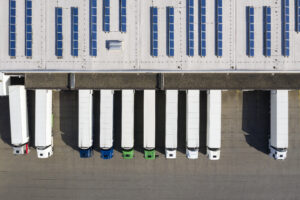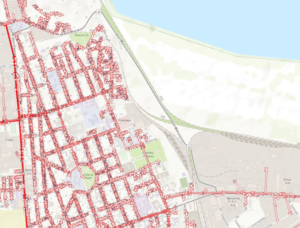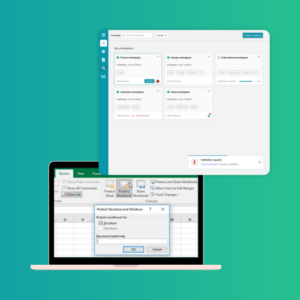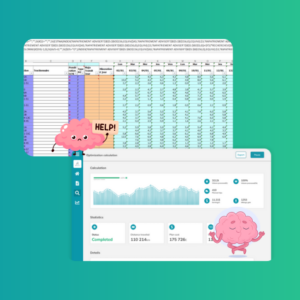


Digital twins are increasingly popular tools to support the digitalisation of our industrial and supply chain activities.
Digital twins have become indispensable, making it possible to consider the functioning of complex installations and behaviours on the largest scale and by crossing technical, environmental and economic data.
However, one must be careful not to fall into certain traps when choosing to turn to these solutions. How can we envisage the next stage of the digital transition of companies thanks to this tool? DCbrain helps you to successfully build such a tool and make it available to several teams in the company.
A digital twin is a description of the static components of a real system or process on which are superimposed dynamic quantities that characterise their operation.
They need the power of databases, mathematical modelling and sensors to display the most relevant metrics for your industrial process. They rely on knowledge often gathered over the years, concentrated in asset inventories, Business Intelligence (BI) software or Geographic Information Systems (GIS). The rise of sensors now makes it possible to associate dynamic data to learn more and more about the functioning of the work tools to be optimised.
Although the digital twin is at the heart of a digitisation process, it does not guarantee its full success. You will also need the right visualisations to enable your staff to use it. This careful balance between modelling functionality, maximum consideration of criteria, user experience and quality of representation is necessary when it comes to bringing a new tool into the hands of business teams.
It should be noted that adoption by operational teams is conditioned by the quality of the results produced. This does not, however, presage an ability to report or to make clear an operational prescription. It is therefore necessary to choose a solution that will allow you to have both, the success of your project being related to the weakest link in the system.
The economic relevance of the data used to build a digital twin has not always been obvious. Consistency and completeness of repositories are tedious qualities to ensure. We are thinking here in particular of compliance with standards in data formats, the absence of redundancies or inconsistencies in these data, ease of updating and maintenance, and proximity to the reality on the ground.
So we must now face these challenges with new perspectives in mind. If it was not obvious to make a measurement or inventory campaign in the field profitable yesterday, the new efficiency levers made possible by digital twins now make it possible to reduce the return on investment time. This payback period is generally defined as the ratio between the savings actually identified as a result of the digital twin and the IT costs involved.
| ROI = (Savings from the study of digital duplication in €) / (IT costs (€) + Data collection costs (€) + Change management costs (€)) |
There is no need to list the necessary data, as it depends very much on the subject to be dealt with. Digital twins allow a large number of different data to be cross-referenced.
In the case of networks and infrastructures, the sites or machines that make up the network, the links that connect them and their main characteristics are the most important. For example, warehouses, customer sites and truck routes in a supply chain network. This is complemented by measurements of what circulates in the network, flows and units over time.
The databases useful for these approaches were initially set up by operational pragmatism, their creators guided by the daily needs of the field. Today, in terms of network infrastructures, these are projects that are increasingly constrained by regulations and represent major cost items for companies. The opportunity to use this data more widely to make other processes more efficient is now available.
Useful data come mainly from:
It is now necessary to strengthen the general quality control and industrialisation capacities to ensure their sustainability. This includes the use of an ETL to perform the necessary validations and replicate the processes developed once. You will probably need to be able to translate business rules into these processes. In any case, the digital duplicate you are about to create will reproduce the same weaknesses as the data presented at the input. The result evolves with the quality of the data, as the maturity of the digital duplicate is neither binary nor fixed.
Finally, among other tools, the digital twin brings with it a series of changes that need to be accepted by the teams. Employees can become players in the process to ensure that the results are in line with working methods.
For the past 5 years, DCbrain has been deploying its pioneering solutions to bring the power of digital twins to its clients. They have made it possible to provide prescriptive solutions for the operation of gas networks, the simulation of fluid propagation and the optimisation of transport plans for large supply chain networks.

Propagation of biomethane in a residential area – Openstreetmap mapping and contributors
The simulation of biomethane propagation in a gas distribution network may be necessary to adapt the billing of end consumers due to the differences in thermal capacities with natural gas. These simulations require a good knowledge of the network, driven by increasingly precise regulations for mapping sensitive networks. The convergence of mapping and measurement data, pressure and flow rate readings, makes it possible to obtain the result shown opposite, which is very visual for the operator. It is thus possible to monitor the impact of new biomethane production in an existing network, to adapt its operation to maximise the zone of influence and limit its unavailability.
It is clear that without topologically connected network mapping or regular measurements, the quality of simulation will suffer and the digital network duplicate needs stability to obtain comparable results over time. Supply chain networks, especially transport networks, have increasingly important reliability objectives. Depending on the products transported and the mode of transport, security constraints impose particular operations. In order to preserve operational margins and to take into account the complexity of the activity and its regulations, the optimisation of the truck routes requires a precise digital double of the existing network. This can be achieved by concentrating parcels in the same truck or by inserting stages in the routes. By combining this with detailed knowledge of the configurations and routings in the warehouses, it is also possible to organise the rotation of teams and driver schedules in the short and medium term.

These tools allow us to:
The business data describing the gas, utility or logistics networks we are used to working on are conveniently mixed with other information, such as weather or road mapping. These associations allow for enriched simulations to take into account reality and detect anomalies. Our software INES is able to work on different networks with identical functioning and quality standards.
The digital twin is the cornerstone of many transformation operations. The support of an experienced team makes it easier to overcome obstacles and identify the most effective action levers more quickly. Regular collaboration between the business teams, the sponsor and DCbrain to achieve the most useful results for your business. Although the lack of technical standards, particularly in the formalisation of the data required to build a digital duplicate, means that we now have to deal with situations on a case-by-case basis, there is no need to reinvent what is already working.
Our solutions accept both very simple flat file formats (csv, xml) or can call on existing APIs in your industrial infrastructures to limit the IT costs involved and quickly produce a first exploitable result. If little data is required to obtain the first results, it is necessary to ensure their quality and to build an industrialisable and sustainable architecture.
Explore our references or get in touch for a product demo!
Glossary


